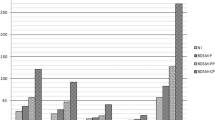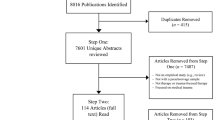Abstract
Child sexual abuse (CSA) is a social problem that often inflicts long lasting psychological trauma and leads to psychopathology, behavioural problems and re-victimization. Treating young people who are presenting with the detrimental effects of CSA is often difficult because these effects off-set efforts at establishing a therapeutic bond. Animals have been found to facilitate the development of the therapeutic alliance between client and practitioner and therapies utilizing horses have the added bonus of empowering clients. This study aimed to evaluate an Equine Facilitated Program (EFT) run by Phoenix House, a sexual assault referral centre in Queensland, Australia. Participants were six boys and nine girls (aged 8–11 years) and 15 adolescent girls (aged 12–17 years). All participants provided several measures of data designed to establish levels of psychological distress at three points in time. That is, Time 1—intake into the service; Time 2—following approximately 6 weeks of in-clinic counselling and pre-EFT; and Time 3 post-EFT (9–10 week duration). Significant improvements in functioning were found between Time 2 and Time 3 assessment across all psychometric measures and for both age groups. No, or non-significant, improvements were found between Time 1 and Time 2 assessments. Overall the results show that EFT proved an effective therapeutic approach for the children and adolescents referred to the service. Of particular note was the finding that efficacy was similar across gender, age and Indigenous/non-Indigenous status. Implications of this and suggestions for further research are discussed.
Similar content being viewed by others
References
Achenbach, T. (1991). Integrative Guide to the 1991 CBCL/4-18, YSR, and TRF Profiles. Burlington: University of Vermont, Department of Psychology.
Achenbach, T., & Rescorla, L. (2001). Manual for ASEABA School-Age Forms and Profiles. Burlington: Library of Congress.
Australian Bureau of Statistics (2005). Personal safety survey. Retrieved from http://www.abs.gov.au/ausstats/abs@.nsf/mf/4906.0.
Australian Institute of Health & Welfare (2011). Child protection in Australia quick facts 2010-201. Retrieved from http://www.aihw.gov.au/child-protection/#facts.
Beck, A. T., Steer, R. A., Ball, R., & Ranieri, W. F. (1996). Comparison of Beck Depression Inventories-IA and -II in psychiatric outpatients. Journal of Personality Assessment, 67(3), 588–597.
Belsky, J. (1993). Etiology of child maltreatment: A developmental-ecological analysis. Psychological Bulletin, 114(3), 413–434.
Bizub, A., Joy, A., & Davidson, L. (2003). “It’s like being in another world”: Demonstrating the benefits of therapeutic horseback riding for individuals with psychiatric disability. Psychiatric Rehabilitation Journal, 26(4), 377–384.
Carlson, J. (2012). Children’s Depression Inventory—Revised. In R. A. Spies & B. S. Plake (Eds.), The seventeenth mental measurements yearbook. Lincoln, NE: Buros Institute of Mental Measurements.
Chardonnens, E. (2009). The use of animals as co-therapists on a farm: The child-horse bond in person-centred equine-assisted psychotherapy. Person-Centred and Experiential Psychotherapies, 8(4), 319–332.
Cohen, J., Deblinger, E., Mannarino, A., & de Arellano, M. (2001). The importance of culture in treating abused and neglected children: An empirical review. Child Maltreatment, 6, 148–157.
Cokor, D., & McGinn, L. (2006). History of child abuse and severity of adult depression: The mediating role of cognitive schema. Journal of Child Sexual Abuse, 15(3), 19–34.
Cole, D., & Martin, N. (2005). The longitudinal structure of the Children’s Depression Inventory: Testing a latent state-trait model. Psychological Assessment, 17(2), 144–155.
Cooper, H., Hedges, L. V., & Valentine, J. C. (2009). The handbook of research synthesis and meta-analysis (2nd ed.). New York: Russell Sage Foundation.
Corcoran, J., & Pillai, V. (2008). A meta-analysis of parent-involved treatment for child sexual abuse. Research on Social Work Practice, 18, 453–464.
Daigneault, I., Herbert, M., & Touigny, M. (2006). Attributions and coping in sexually abused adolescents referred for group treatment. Journal of Child Sexual Abuse, 15(3), 35–59.
Dowd, T. (2012). Review of the Beck Anxiety Inventory [1993 Edition]. In R. A. Spies & B. S. Plake (Eds.), The seventeenth mental measurements yearbook. Lincoln, NE: Buros Institute of Mental Measurements.
Draucker, C., Martsolf, D., Roller, C., Knapik, G., Ross, R., & Stidham, A. (2011). Healing from childhood sexual abuse: A theoretical model. Journal of Child Sexual Abuse, 20, 435–466.
Equine Assisted Growth and Learning Academy (EAGALA) (2012) http://www.eagala.org/Information/, Accessed Sep 2012.
Evans, N., & Gray, C. (2012). The practice and ethics of animal-assisted therapy with children and young people: Is it enough that we don’t eat our co-workers? British Journal of Social Work, 42(4), 600–617.
Ewing, C., MacDonald, P., Taylor, M., & Bowers, M. (2007). Equine-facilitated learning for youths with severe emotional disorders: a quantitative and qualitative study. Child and Youth Care Forum, 36, 59–72.
Field, A. (2009). Discovering statistics using SPSS (3rd ed.). London: Sage Publications Ltd.
Fleming, J., Mullen, P., Sibthorpe, B., & Bammer, G. (1999). The long-term impact of childhood sexual abuse in Australian women. Child Abuse and Neglect, 23, 145–159.
Froeschle, J. (2009). Empowering abused women through equine assisted career therapy. Journal of Creativity in Mental Health, 4(2), 181–190.
Geist, T. (2011). Conceptual framework for animal assisted therapy. Child and Adolescent Social Work, 28, 243–256.
Gibb, B., Alloy, L., & Abramson, L. (2003). Global reports of childhood maltreatment versus recall of specific maltreatment experiences: Relationships with dysfunctional attitudes and depressive symptoms. Cognition and Emotion, 17(6), 903–915.
Gibson, L., & Leitenberg, H. (2001). The impact of child sexual abuse and stigma on methods of coping with sexual assault among undergraduate women. Child Abuse and Neglect, 25, 1343–1361.
Karol, J. (2007). Applying a traditional individual psychotherapy model to equine-facilitated psychotherapy (EFP): Theory and method. Clinical Child Psychology and Psychiatry, 12(1), 77–90.
Kendall-Tackett, K. (2002). The health effects of childhood abuse: four pathways by which abuse can influence health. Child Abuse and Neglect, 26, 715–729.
Kovacs, M. (2003). Children’s Depression Inventory (CDI): Technical manual update. North Tonawanda: Multi-Health Systems.
Lalor, K., & McElvaney, R. (2010). Child sexual abuse, links to later sexual exploitation/high-risk sexual behavior, and prevention/treatment programs. Trauma, Violence and Abuse, 11, 159–177.
Lanktree, C., & Briere, J. (1995). Outcome of therapy for sexually abused children: A repeated measures study. Child Abuse and Neglect, 19, 1145–1155.
Mackler, K. (2012). Review of the Trauma Symptom Checklist for Children By: Briere, John, Mental Measurements Yearbook, 15. Retrieved from http://web.ebscohost.com.ezproxy.cqu.edu.au/ehost.
Marino, L. (2012). Construct validity of animal-assisted therapy: How important is the animal in AAT? Anthrozoös, 25(supplement), 139–151.
Melson, G. (2011). Principles for human-animal interaction research. In P., McCardle, S., McCune, A., Griffin, & V., Maholmes, (eds.), How animals effect us: Examining the influence of human-animal interaction on child development and human health. Washington, DC: American Psychological Association.
Merrill, L., Thomsen, C., Crouch, J., May, P., Gold, S., & Milner, S. (2005). Predicting adult risk of physical abuse from childhood exposure to violence: Can interpersonal schemata explain the association? Journal of Social and Clinical Psychology, 24(7), 981–1002.
Morrison, M. (2007). Health benefits of animal-assisted interventions. Complementary Health Practice Review, 12(1), 51–62.
Nimer, J., & Lundahl, B. (2007). Animal-assisted therapy: A meta-analysis. Anthrozoös, 20(3), 225–238.
Ponce, A., Williams, M., & Allen, G. (2004). Experience of maltreatment as a child and the acceptance of violence in adult intimate relationships: Mediating effects of distortions in cognitive schema. Violence and Victims, 19(1), 97–108.
Price-Roberston, R., Bromfield, L., & Vassallo, S. (2010). The prevalence of child abuse and neglect. Australian Institute of Family Studies Retrieved from http://www.aifs.gov.au/nch/pubs/sheets/rs21/rs21.html.
Reichert, E. (1998). Individual counselling for sexually abused children: A role for animals and storytelling. Child and Adolescent Social Work Journal, 15(3), 177–185.
Richards, K. (2011). Misperceptions about child sex offenders. No: Trends & Issues in Crime and Criminal Justice. 429.
Roberts, F., Bradberry, J., & Williams, C. (2004). Equine-facilitated psychotherapy benefits students and children. Holistic Nursing Practice, 18(1), 32–35.
Sánchez-Meca, J., Rosa-Alcázar, A., & López-Soler, C. (2011). The psychological treatment of sexual abuse in children and adolescents: A meta-analysis. International Journal of Clinical and Health Psychology, 11, 67–93.
Schultz, P., Remick-Barlow, G., & Robbins, L. (2007). Equine-assisted psychotherapy: A mental health promotion/intervention modality for children who have experienced intra-family violence. Health and Social Care in the Community, 15(3), 265–271.
Serpell, J. (2006). Animal-assisted interventions in historical perspective. In A. Fine (Ed.), Handbook on animal-assisted therapy: Theoretical foundations and guidelines for practice. San Diego: Elsevier/Academic Press.
Strand, V., Sarmiento, T., & Pasquale, L. (2005). Assessment and screening tools for trauma in children and adolescents: A review. Trauma, Violence and Abuse, 6(1), 55–78.
Thompson, K., & Gullone, E. (2003). Promotion of empathy and prosocial behaviour in children through humane education. Australian Psychologist, 38(3), 175–182.
Trotter, K., Chandler, C., Goodwin-Bond, D., & Casey, J. (2008). A comparative study of the efficacy of group equine assisted counselling with at-risk children and adolescents. Journal of Creativity in Mental Health, 3(3), 254–284.
Tsai, C.-C., Friedman, E., & Thomas, S. A. (2010). The effect of animal-assisted therapy on stress responses in hospitalized children. Anthrozoös, 23(3), 245–258.
Westerman, T. (2010). Engaging Australian Aboriginal youth in mental health services. Australian Psychologist, 45(3), 212–222.
Author information
Authors and Affiliations
Corresponding author
Rights and permissions
About this article
Cite this article
Kemp, K., Signal, T., Botros, H. et al. Equine Facilitated Therapy with Children and Adolescents Who Have Been Sexually Abused: A Program Evaluation Study. J Child Fam Stud 23, 558–566 (2014). https://doi.org/10.1007/s10826-013-9718-1
Published:
Issue Date:
DOI: https://doi.org/10.1007/s10826-013-9718-1




